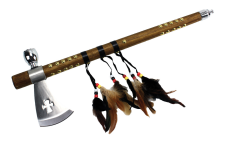Kenka-Kiseru: The Japanese Fighting Pipe
Perhaps the most interesting aspect of the kiseru is its adaptability as both a smoking implement and a weapon of self defense. At the time when smoking was first introduced, Japan was experiencing the waning years of the Sengoku Jidai, or Warring States period, when the nation was in a near-constant state of war among the powerful samurai clans that sought to assume the office of Shogun.
The possibility of violence was an omnipresent reality at all levels of society, and many systems of martial arts were developed using a wide array of items, from bamboo flutes to, in this case, tobacco pipes. Even after the Tokugawa Shogunate brought relative stability to Japan, crime syndicates abounded in the cities of the Edo period, leading pipe makers to devise specialized kiseru that could function as truncheons in situations where diplomacy was insufficient.
... many systems of martial arts were developed using a wide array of items, from bamboo flutes to, in this case, tobacco pipes
These kiseru were considerably larger than their counterparts, with many exaggerating the size of the bowl and mouthpiece to mace-like proportions while retaining a relatively short overall length. Other fighting pipes were exceptionally long and made of iron, some including studs on the mid-section to afford a surer grip and wielded like shortswords. Such pipes were especially popular among the bakuto, forerunners of the famous Yakuza clans who were notorious for operating illegal gambling dens, doubling as loan-sharks for shady clients. Kenka-kiseru afforded them weapons that could be carried openly on their belts without arousing much suspicion from the authorities.
Over time, a dedicated form of martial arts was developed around using these pipes and was called kiseru-jutsu, modeled after earlier forms that employed the tessen, or war-fan. I can imagine that after a long day of fighting rival gangsters and extorting the peasantry, kenka-kiseru could provide a particularly satisfying smoke.
(Source: https://www.smokingpipes.com/smokin...verview-the-traditional-japanese-smoking-pipe)









